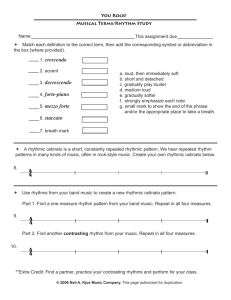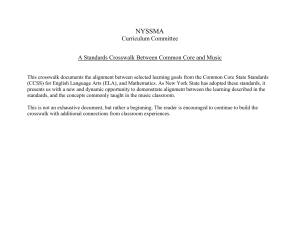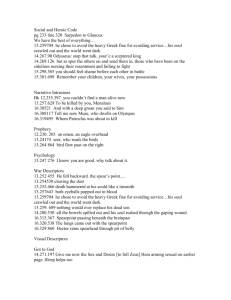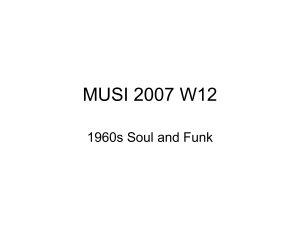Soul, Funk and Disco
advertisement
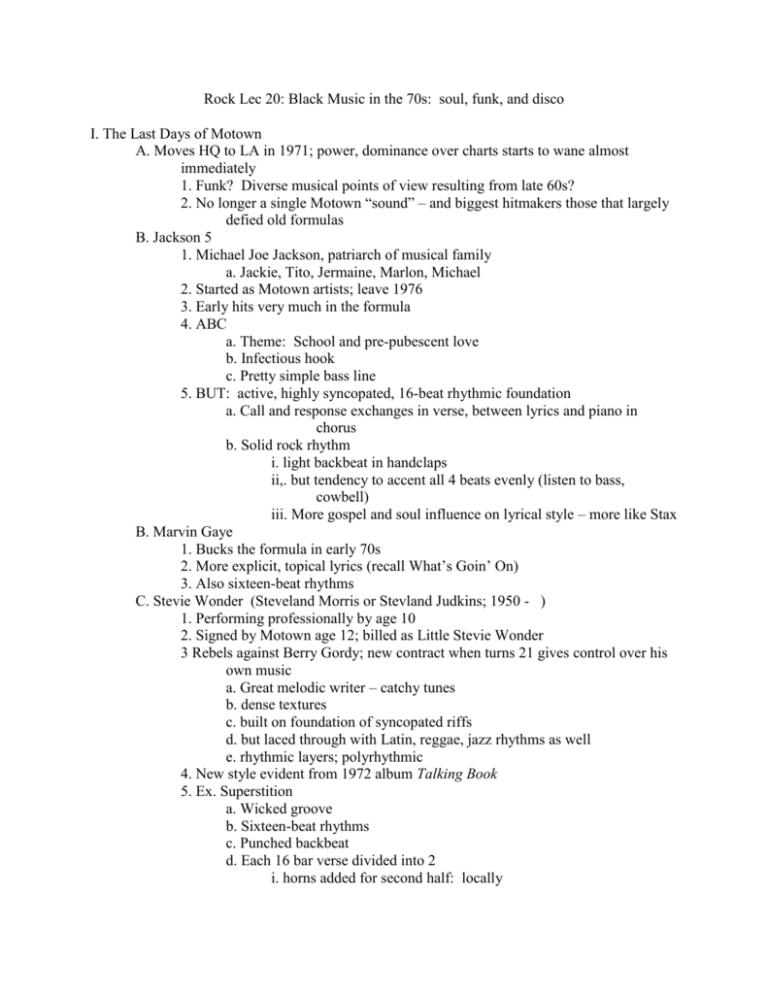
Rock Lec 20: Black Music in the 70s: soul, funk, and disco I. The Last Days of Motown A. Moves HQ to LA in 1971; power, dominance over charts starts to wane almost immediately 1. Funk? Diverse musical points of view resulting from late 60s? 2. No longer a single Motown “sound” – and biggest hitmakers those that largely defied old formulas B. Jackson 5 1. Michael Joe Jackson, patriarch of musical family a. Jackie, Tito, Jermaine, Marlon, Michael 2. Started as Motown artists; leave 1976 3. Early hits very much in the formula 4. ABC a. Theme: School and pre-pubescent love b. Infectious hook c. Pretty simple bass line 5. BUT: active, highly syncopated, 16-beat rhythmic foundation a. Call and response exchanges in verse, between lyrics and piano in chorus b. Solid rock rhythm i. light backbeat in handclaps ii,. but tendency to accent all 4 beats evenly (listen to bass, cowbell) iii. More gospel and soul influence on lyrical style – more like Stax B. Marvin Gaye 1. Bucks the formula in early 70s 2. More explicit, topical lyrics (recall What’s Goin’ On) 3. Also sixteen-beat rhythms C. Stevie Wonder (Steveland Morris or Stevland Judkins; 1950 - ) 1. Performing professionally by age 10 2. Signed by Motown age 12; billed as Little Stevie Wonder 3 Rebels against Berry Gordy; new contract when turns 21 gives control over his own music a. Great melodic writer – catchy tunes b. dense textures c. built on foundation of syncopated riffs d. but laced through with Latin, reggae, jazz rhythms as well e. rhythmic layers; polyrhythmic 4. New style evident from 1972 album Talking Book 5. Ex. Superstition a. Wicked groove b. Sixteen-beat rhythms c. Punched backbeat d. Each 16 bar verse divided into 2 i. horns added for second half: locally ii. end-weighted iii. Verses static harmonically – built on pentatonic scale iv. Bridge (transition) harmonically active v. Lead to hook; resolved at end of hook e. Series of end-weighted periods 6. 1976 Songs in the Key of Life first album to enter charts at No. 1 II. 70s Soul A. Romantic soul 1. Book calls “Black romantic music” 2. More pop and jazz-oriented R&B 3. Expressive, but lightly rhyhmic a. Sixteen beat rhythms b. But subtle and in background – like Motown 4. Open-ended song forms – not end-weighted 5. Explicit (but not graphic) lyrics 6. Perfect example of what came to be known as just “soul” – Roberta Flack, Feel Like Makin’ Love 7. Grittier, more gospel/Stax soul influenced artists as well a. Bill Withers b. Most popularly known for Lean On Me – very much in style described above c. But also Use Me i. Latin rhythms, fairly accented ii. In your face keyboard riff, with lots of distortion iii. Cool refrain – vocal and percussion – reveals complexity of rhythms aa. Sixteen beat rhythm in cymbals bb. clave rhythm on woodblock cc. Further layering on tom-toms, snare (almost reverse clave) iv. Subtly end-weighted – VERY subtly aa. 16th rhythm in cymbal doesn’t start until 1st statement of refrain bb. Hand claps added in 2nd half of 2nd verse cc. Long outro B. Gospel/soul 1. Fusion of soul, gospel (yes, re-infusion) 2. Personified in Al Green a. Book calls “voice of soul in the 70s” b. Certainly one of the principal c. Started as gospel singer; maintained virtuoso, gospel stylings even when recording black romantic soul songs i. Melismas ii. Falsetto shouts, moans, stutters – wide variety of vocal techniques iii. Huge range of tone colors (distinct vocal sounds) iv. Also wide range v. Certain similarity to Otis Redding style, but even wider range of techniques in play d. Vocal virtuosity, to certain extent, replaces rhythmic drive or lyric message 3. Ex. Tired of Being Alone a. Affinity with late 60s Motown sound evident b. As is ties to Stax Soul i. Horn punctuation ii. Hard emphasis on backbeat iii. Gospel influence on vocal styles c. But also new influences i. Four part backing harmonies – simulated choir? ii. Almost no studio production C. And then there is the smooth, soulful seductive “mood music” 1. Spoken or speech inflected lyrics 2. Quite explicit lyrics 3. Over rhythmic ostinato 4. Colored with “wall of sound” type effects 5. Example: The minister of love, Barry White – I’m Gonna Love You Just a Little More Baby III. Philadelphia Sound A. When discussed soul, mentioned the slightly different, regional sound of Philly soul B. Producers Kenny Gamble and Leon Huff 1. Formed Philadelphia International Records in early 70s 2. Part of success wicked tight studio band MFSB (Mother, Father, Sister, Brother) a. Highly produced – dense textures i. Strings ii. Vibraphones iii. Horns iv. Latin percussion b. Lighter sound than the “Wall” i. Guitars, synthesizers fed directly into board ii. Relatively little reverb or echo c. Riff-based d. Much harder, rock-style timekeeping C. First major success: The O’Jays 1. Temptations-like sound 2. But jazzier feel to rhythms 3. Also more stylistically influenced by Stax soul 4. First major hit Back Stabbers (1972) -Listen for above characteristics 5. 1974 – Love Train a huge smash D. Same characteristics in Spinners, Could It Be I’m Fallin In Love . TSOP (The Sound of Philadelphia) – number 1 hit in 1974, became theme for Soul IV. Funk A. General 1. Influence of James Brown on black music still very much in force a. Rhythm the driving influence b. Dense, rhythmic layering c. Over syncopated riffs 2. Late 60s-early 70s rhythms get even more complex a. Sixteen-beat rhythmic foundation standard b. Creates more cross-rhythmic conflict between lines c. Polyrhythmic – several independent rhythmic lines at once d. Syncopated bass lines, guitar riffs i. Percussiveness emphasized by removing or weakening pitch ii. Choked guitar sound iii. “Slapped” bass – bump or slap strings with side of thumb, rather than pluck e. short vocal phrases f. Lots of repetition of words and phrases g. conversational delivery B. Takes on a new flavor – and transmitted to wider audience – through Sly and the Family Stone (Sylvester Stewart, Freddie Stewart, more) 1. Formed band The Stoners in 1966, evolved into Sly and the Family a. Interracial band c. male and female members (trumpeter Cynthia Robinson, pianist Rose “Stone” Stewart 2. Appearance at Woodstock introduced to mainstream, white audience 3. Fusion of soul, psychedelic rock, and new James Brown 4. Riff driven polyrhythmic structure 5. over minimal chord changes or pentatonic scales 6. From psychedelia - fuzztone and distortion effects 7. Avoided strong backbeat; all four beats accented evenly, and heavily a. Flat four beat b. This is the defining characteristic of funk 8. Horns - Something like update of Booker T. and the MGs 9. Thank You Falettinme Be Mice Elf Agin a. Primarily 8 bar sections i. most have new lyrics on each repetition ii. Others are refrain – “Thank you, for lettin’ me, be mice elf….” b. Polyrhythms created between separate patterns of guitar, bass, var. drums c. Lots o’ rhythmic layering d. Particularly evident electronic manipulation of guitars i. Wah-wah riff in guitar, with very little reverb ii. Becomes a standard tone color of funk e. Popped bass – strings plucked sharply, with great force f. Together – short, percussive string sounds g. Dense, intricate texture composed of at least five or six layers of rhythmic activity h. Can’t imagine where another rhythmic layer would go! 10. Check out other examples on web site D. Parliament/George Clinton 1. Started as Parliaments, vocal group styled after the Temptations 2. Clinton hired as songwriter for Motown, but his group not signed to label – too MUCH a. Rather outre stage personna b. Picked up by smaller label 3. Parliaments renamed Parliament, become the premiere funk band for more than a decade b. All of the above characteristics plus c. Hendrix-like distorted guitar d. Conversational lyrics, indirectly addressing political and social themes, often in satirical way (ala Zappa) e. Outer space-science fiction characters/song themes 4. 1968 Clinton forms Funkadelic: horror movie characters/themes a. Bands performed together, shared members, but remained separate b. Went under number of names; generally collectively known as P-Funk c. funk as aesthetic, antithesis of mainstream culture 5. Fusion of hard rock, R&B songwriting and harmonies a. James Brown influenced funk b. Motown roots evident – glimpses of doo-wop, pop song construction 6. Art rock influences as well – mixed meters, sophisticated jazz rhythms, shifting patterns of accents 7. Wider palate of tone colors 8. Even denser textures (unbelievable, but true) 9. Sixteen-beat rhythm often lacking – eight is more normal 10. Ex. – Up For the Down Stroke 11. Link between older black music traditions and hip-hop culture E. Funk tradition continued in 80s, 90s by Clinton, Red Hot Chili Peppers V. Disco A. What happened to funk? 1. Disco short for discotheque – dance clubs 2. In U.S., began as Philadelphia, Detroit soul popular in African-American and gay dance clubs 3. Two turntables so could move smoothly from one song to another, with no interruption in dance groove – one long song 4. Each beat strongly accented – flat four beat a. And subdivided into sixteenth note rhythms b. Even emphasis on all – “four on the floor” rhythms c. Makes it very easy to dance to – rhythm evident 5. Approximately same number of BPM in most disco songs = 108-126 a. Faster than most funk songs b. Thinner textures result in peppier sound 6. Often have party sounds, whistles in background B. One of first disco groups - KC and the Sunshine Band 1. Huge hit in 1975 with That’s The Way (I Like It) 2. Ubiquitous use of title as hook, expanded with (Uh-huh, Uh-huh) 3. Percussion-heavy texture 4. Several layers of riffs 5. Heavily produced 6. Four on the floor sixteen beat rhythm on cymbal 7. Unmistakable Latin flavor 8. “disco rhythm” 1 + 2 e+a 3e +a 4e +a C. Saturday Night Fever 1. Spreads disco to mainstream audience 2. Soundtrack: Made the BeeGees superstars, 3 top ten hits from album: How Deep Is Your Love, Night Fever, Stayin’ Alive
